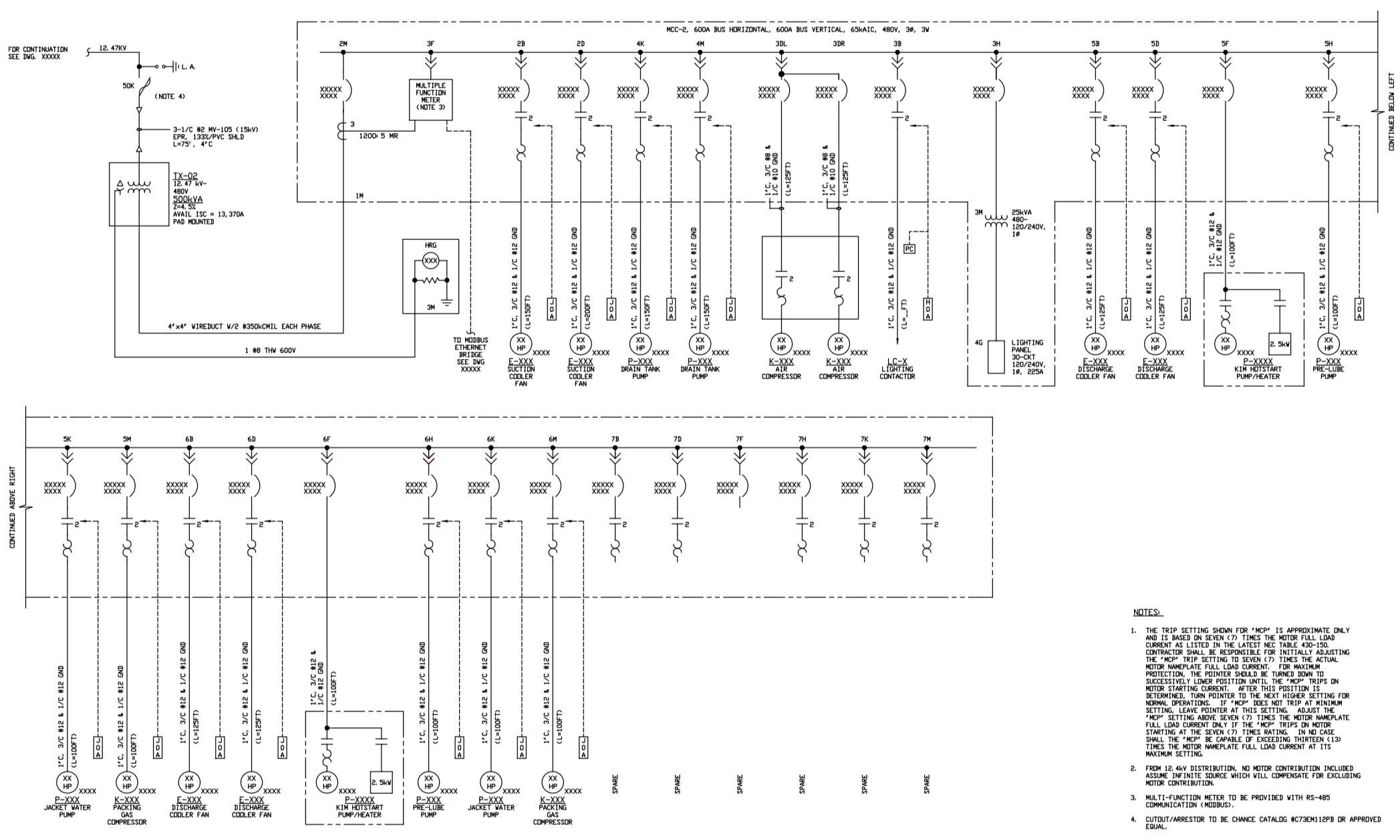Electrical One Line Diagram
An electrical one line diagram (or single line diagram, SLD) is a simplified drawing used to represent the power system in a plant. The purpose of single line diagram is to diagrammatically show sources of power, electrical equipment loads, electrical drives, system details and fault levels. Single line or one-line diagrams get their name from the fact only one phase of three phase system is shown and only one line is used to represent any number of current carrying conductors.
During the design process, the SLD is extremely important as nearly every electrical engineering and design document relies on the one line to accurately depict how the system will function.
Just like Piping and Instrumentation Diagrams, the one line diagram reflects electrical relationships and sequences relative to each-other and does not represent geographic relationships. In order to create the single line diagram, the P&ID should be fairly well established and an electrical load study should be completed. As equipment is finalized or updated, the one line should be updated.
On an SLD, standard symbols are used to represent components of power systems, such as transformers, circuit breakers, generators, fuses and switches. Like any schematic drawing, an electrical one line diagram should include a legend which details the various symbols being used.
Some of the more common symbols can be found here. <<ADD LINK>>
One Line Diagram Usage
Whether it is in a new or existing facility, the single-line diagram is a roadmap for electrical engineering drawings and documents, future testing, service and maintenance activities. Like any drawing, the single-line diagram is a snapshot of the facility at a moment in time. Similar to a piping and instrumentation diagram, as changes are made to the facility, it must be kept up to date. Additionally, having an up-to-date single line diagram is a requirement to NFPA 70E (Standard for Electrical Safety in the Workplace).
- Some of the engineering and design documents directly affected by a one line are -
- Transformer & Generator specification
- Motor Control Center schedules & schematics
- Panel Schedules
- Switch Rack Design
- Arc Flash Analysis
- UPS Sizing
- Motor Wiring Diagrams
- Electrical studies and project activities affected by the one line are -
- Short circuit calculations
- Coordination studies
- Load flow studies
- Grounding assessments
- Safety evaluation studies
- Electrical safety procedures
- Efficient maintenance planning and execution
- A typical package of single line diagram can include -
- Power Sources - Generators, transformers (rating, winding connection and grounding means), voltages available short-circuit current, and grounding methods of separately derived sources should be included.
- Metering and Relaying - Meter types, relay types, CT and PT ratios.
- Transformers - Capacity, voltages, impedance, connection, and grounding method.
- Buses and Bus Duct - Voltage, current rating, and short circuit bracing.
- Medium Voltage Switchgear - Current rating and MVA rating.
- Medium Voltage Motor Starters - Current rating.
- Low Voltage Switchgear - Current rating, frame size, trip setting, and options (e.g., LT, ST, I.)
- Low Voltage Motor Control Centers - Current rating, frame size, and trip setting of molded case circuit breakers, and NEMA sizes of starters
- Fuses - Size and type
- Feeders - Size, number of conductors, and conduit sizes
- Loads - All connected loads, their size and description. Be sure to include the individual load capacity.
- Critical Equipment - Voltage and sizes of UPS, battery, generators, power distribution, transfer switch, computer room air conditioning are some examples.
- Expansions and Upgrades - If known, include known expansions and upgrades. This will assist in equipment sizing and specification.
One Line Diagram/ Single Line Diagram Example
The drawing below is an example of a single line diagram that was used to design a 100+ well test and metering facility. Click on the drawing to zoom in.


